
Faculty Research 1990 - 1999
Germline V genes encode viable motheaten mouse autoantibodies against thymocytes and red blood cells.
Document Type
Article
Publication Date
1990
Keywords
Antigens-Ly: an, Autoantibodies: ge, B-Lymphocytes: ph, Base-Sequence, Blotting-Northern, Blotting-Southern, Erythrocytes: im, Genes-Immunoglobulin, Immunoglobulin-Variable-Region: ge, Immunoglobulins-Heavy-Chain: ge, Immunoglobulins-Kappa-Chain: ge, Lymphocyte-Transformation, Mice, Mice-Mutant-Strains: ge, Molecular-Sequence-Data, Oligonucleotide-Probes, Polymerase-Chain-Reaction, Support-Non-U, S, -Gov't, Support-U, S, -Gov't-P, H, S, Thymus-Gland: im
First Page
2304
Last Page
2311
JAX Source
J Immunol 1990 Oct 1; 145(7):2304-11.
Grant
AI24671, AI20232, AI25765
Abstract
Autoantibodies against thymocytes and RBC may contribute to the pathophysiology of homozygous viable motheaten (mev) autoimmune disease. Whether the production of these autoantibodies in mev mouse results from polyclonal nonspecific B cell activation or specific Ag-driven stimulation is not known. To understand the mechanisms involved in the induction of antithymocyte autoantibody response in mev mouse, we have studied the fine antigenic specificity, structure, and origin of three antithymocyte autoantibodies derived from mev splenic B cell hybridomas. Western blot analysis showed that these mAb bind to polypeptides of 33 and 105 kDa present in RBC and thymocytes, respectively. Additional specificities for the epitopes present in other polypeptides distinguished these three autoantibodies. Northern hybridization and flow microfluorimetry analysis indicated that these hybridomas are derived from the Ly1+ B cell subset. These autoreactive Ly-1 B cell hybridomas, chosen on the basis of their specificity, expressed L chain V genes from a single VK family (VK9) and VH genes from J606 and S107 families. Hybridomas UN34.11 and UN42.5 expressed the VK9 gene identical to that used by peritoneal Ly1+ B cells from various mouse strains and malignant B lymphoma cells secreting anti-mouse RBC treated with proteolytic enzyme bromelin and anti-SRBC antibodies. The third hybridoma, S2-14.2, used a VK9 gene identical to that expressed by MOPC41. None of the VK genes encoding these autoantibodies showed any somatic mutations. In the case of VH genes, the two hybridomas UN42.5 and S2-14.2 derived from two separate fusions, used identical VH genes from the J606 family. The third hybridoma UN34.11 used unmutated V11 germline VH gene, a member of the S107 family. Southern hybridizations, using oligonucleotide probes specific for CDR1 and CDR2, showed that the VH genes encoding the J606 autoantibodies were derived from a germline gene found in the 6.7-kb fragment of EcoRI-digested germline DNA. This germline VH gene is distinct from VH22.1 germline gene that codes for antigalactan antibodies. Sequence analysis of this gene showed perfect homology with the rearranged VH genes confirming the lack of somatic mutations. Thus, our data demonstrate that antithymocyte antibody response occurring in mev mouse is polyclonal and it involves Ly-1 B cells expressing unmutated germline VH and VK genes. These results indicate that antigen driven stimulation may not play an important role in the induction of anti-thymocyte antibody response in mev mouse.
Recommended Citation
Kasturi KN,
Mayer R,
Bona CA,
Scott VE,
Sidman CL.
Germline V genes encode viable motheaten mouse autoantibodies against thymocytes and red blood cells. J Immunol 1990 Oct 1; 145(7):2304-11.

